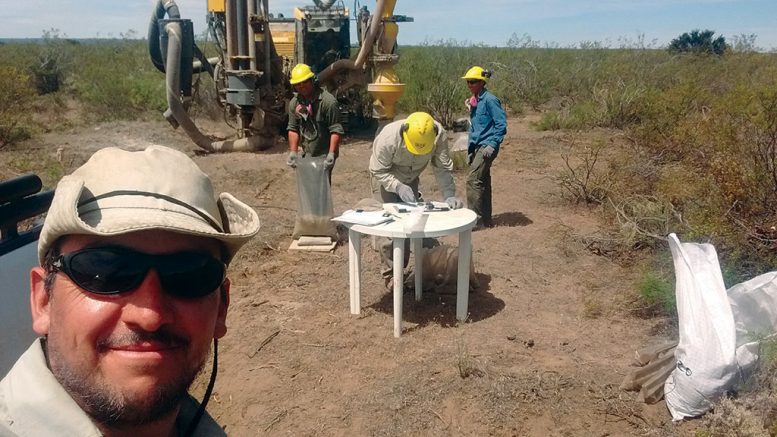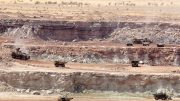Argentina has three nuclear reactors and plans for more, yet the country has no domestic uranium production. Blue Sky Uranium (TSXV: BSK; US-OTC: BKUCF) hopes to fill that void.
“They import uranium from Kazakhstan and Canada, so having a domestic source would be a preference, and they’re potentially our first customer,” Nikolaos Cacos, the company’s president and CEO, tells The Northern Miner.
The country exports small nuclear reactors, too, which are built by INVAP, a manufacturer in the province of Rio Negro, home of Blue Sky Uranium’s Amarillo Grande project.
“The province is a majority owner of INVAP — it’s like a crown corporation — and we’ve collaborated with this organization doing some metallurgical studies, so they’re very supportive of what we’re doing,” says Cacos. “They even have a pilot nuclear enrichment plant in Rio Negro … If we had to pick a province to do uranium mining in, there couldn’t be a better one.”
In February, the company completed a preliminary economic assessment (PEA) of its main Ivana deposit at Amarillo Grande. The study outlines an open-pit operation that would produce uranium and vanadium over a mine life of 13 years.
Initial capex is estimated at US$128 million, including a US$28 million contingency, and would be paid back, after-tax, in just under two and a half years. Life of mine sustaining capital costs are forecast at US$35 million.
“The overall capex is very low for any type of mining project, and for a uranium project, too, especially compared with projects in Canada,” Cacos says, adding that sustaining capex is also quite low, as “it’s almost like a gravel operation.”
The majority of the near-surface mineralization found so far is in the form of the leach-amenable mineral carnotite as coatings on pebbles, and beneficiation test work on samples indicates that simple wet scrubbing and screening techniques could be used onsite to concentrate and upgrade the material, which could reduce transport and processing costs.
“The large pebbles are completely un-mineralized so you scoop up a tonne of dirt, you do a wet scrubbing and remove the large pebbles and rock, and you’ve increased the grade by a factor of four and removed 75% of the mass, and the rest is done with a simple alkaline leaching process where you extract the uranium and vanadium out,” he says. “This process is used worldwide and is well-proven.”

A drill rig at Blue Sky Uranium’s Amarillo Grande project in Argentina. Credit: Blue Sky Uranium.
Blue Sky has also hired Chuck Edwards, a technical advisor who specializes in uranium processing for both alkaline and acid leach plants. Edwards was involved in the engineering design of all the current uranium facilities in Saskatchewan’s Athabasca Basin, and has worked on uranium projects in five continents, including as principal metallurgist at Cameco (TSX: CCO).
“He recently retired from Cameco and then starting working on this project,” Cacos says. “The more work he did, the more he liked the project.”
Other estimates in the PEA put total cash costs net of credits over the life of mine at US$16.24 per lb. U3O8 with all-in sustaining costs net of credits of US$18.27 per lb. U3O8.
At a uranium price of US$50 per lb. and a vanadium price of US$15 per lb., the project would yield an after-tax net present value at an 8% discount rate of US$135 million and an after-tax internal rate of return of 29.3%, the study concludes.
“This is a low-cost deposit. It’s surficial, and has very positive economic indicators that can make it viable, even in the uranium environment we’re in right now,” Cacos says, noting that the deposit, an in-house discovery, occurs within a depth of 20 to 25 metres.
“There is no drill hole that goes deeper than 50 metres, so drilling has been very low cost,” he says.
This year, Blue Sky will explore three high priority target areas with significant anomalies of uranium and vanadium, and the work program over the next six months includes up to 4,500 metres of reverse circulation drilling, auger drilling and down-hole radiometric measurements, as well as a six-kilometre induced polarization (IP) geophysical survey.
The program is designed to identify and delineate mineralization between the main Ivana deposit and the Ivana West target, about 1 km away, and also test targets in two other key areas to the north — Ivana Central and Ivana North — all of which are within 25 km of the main deposit.
Cacos is particularly interested in the prospects at Ivana Central, where its former partner, Areva, drilled holes in 2010 and 2011, but never assayed them.
“They very abruptly ended the partnership because I guess they had some restructuring issues to deal with — nothing to do with our project — and so we assayed them,” he says. “The edges of our Ivana main deposit have certain characteristics, and those drill holes on either side, that are about six kilometres apart, seem to mimic those edges. Areva may have just stepped over an underlying deposit.”
Five to ten kilometres further north of Ivana Central, at Ivana North, Blue Sky is also seeing “attractive geology” and “surface expression,” Cacos notes.
On May 27 the company announced a non-brokered private placement financing of up to 9.3 million units at a price of 15¢ per unit for gross proceeds of $1.4 million.
Those funds should “get this exploration program going,” and “will get us into the fall, when the cycle begins to pick up when it traditionally does, [and] we can raise additional funds.”
“This whole drill program is estimated to cost about US$3 million and has the potential to dramatically change the project,” he says.

Carnotite mineralization from the Anit deposit at Blue Sky Uranium’s Amarillo Grande project in Argentina. Credit: Blue Sky Uranium.
As for the uranium price, which is languishing at less than US$25 per lb., Cacos says he’s “optimistic.”
“There are a few things that give me comfort that the uranium price will pick up,” he says. “We’re seeing a lot of interest and a lot more in the mainstream press about the International Atomic Energy Agency, which says developed countries need to look at nuclear power as a viable option in order to reduce greenhouse gases, and we’re seeing a lot more acceptance of that, and I’m reading about that more and more often.”
“We’re also getting a lot more interest from institutional investors and private equity groups in the uranium space … It’s smart money and usually smart money moves first and then retail follows, so those are all positive signs,” he continues. “And we’re seeing nuclear reactors being built around the world. China is investing US$10.5 billion to build a nuclear reactor in Argentina.”
Blue Sky has defined mineralization at Amarillo Grande in three key areas, Ivana, Anit and Santa Barbara, along a 145-km trend.
The Ivana deposit is 25 km north of the city of Valcheta, where Blue Sky has its exploration camp and office. Valcheta is at the junction of Provincial Road 4 and National Road 23, where the latter connects to the deep-ocean port of San Antonio Oeste, 120 km to the east. A railway runs parallel to National Road 23 and two high-power lines crosscut the project from east to west.
At press time, Blue Sky is trading at 14¢ per share in a 52-week range of 12.5¢ to 23¢.
The junior has 110 million common shares outstanding for a $15.4-million market capitalization.




Be the first to comment on "Blue Sky Uranium advances Amarillo in Argentina"